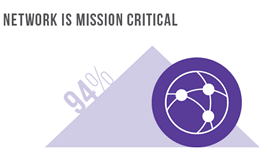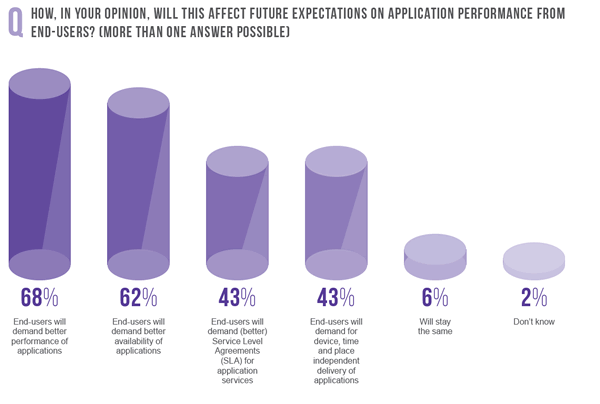The impact of the increasing digital expectations and behavior of workers in the age of digital business is inevitably is felt on the level of network infrastructure. With the mixed network infrastructure reality of today, management and security are two essential challenges.
Another key challenge is meeting the network infrastructure demands in an environment which is characterized by a growing need for high performance and availability, obviously with cloud connectivity as an essential part. A look at this growing need from the perspective of changing worker demands.

Ubiquitous connectivity in a data-intensive reality: the pressure on network infrastructure
It’s easy to forget but underneath all the applications we use for work, private goals and increasingly both at the same time, sit networks and they are evolving in very profound ways, with the growing virtualization of network functions being an essential one (the balance shift from hardware to software in emerging network approaches).
For users of the applications and data which are possible thanks to the network and the cloud, connectivity has become the most normal thing in the world. Workers, just like consumers, see it as electricity: it’s simply there, regardless of the networks behind it. Moreover, it’s not enough that connectivity is there: it needs to be everywhere they are and regardless of device – mobility indeed. Last but not least, it needs to be fast and capable to offer rapid access to more and more applications that require a lot of networking power for workers who demand better performance and availibility in regards to these apps.
In times where people expect ubiquitous connectivity, at the office, on the go or at home, a mix of networks needs to serve their increasing data needs. The forecasted impact of video on mobile data traffic, for instance, is staggering. New data-intensive applications in areas such as the Internet of Things also demand new network approaches whereby capacity moves closer to the device and takes away pressure from networks and other resources, while expectations regarding corporate networks and the cloud continue to push the limits of infrastructural capacity in the extended enterprise.
Worker demands challenging the network
Today’s digital and mobile workers and prosumers won’t express their needs in terms of network infrastructure capacities. They express them in terms of how they experience speed, performance and availability, anywhere and anytime.
Still, in the end the infrastructure makes the difference and defines whether we satisfy or frustrate workers and customers. Research from our partner BT and InfoVista shows the mentioned changing demands for the demographic segment of people born from circa 1980 to 2000, carrying the generational label ‘Generation Y’ (also known as Millennials).
 Looking at the expectations of this age group (keep in mind generational labels are constructs), which is becoming a large part of the workforce, the challenges for network infrastructure demand and application availability become clear and match several priorities of responding IT professionals.
Looking at the expectations of this age group (keep in mind generational labels are constructs), which is becoming a large part of the workforce, the challenges for network infrastructure demand and application availability become clear and match several priorities of responding IT professionals.
The Gen Y workforce wants their end user applications to be easy to use, reflecting the same user experience and simplicity levels as they’re used to in their capacity as ‘consumers’. They want applications to be flexible and adapted to their ways of working and communicating, which is mobile first.
It is unsurprising, that 94% of organizations agree that the network is mission critical. To meet both business demands and the expectations of the evolving workforce it is essential that the network remains fit for purpose at all times. However, the survey highlights that the increased volume of network traffic is NOT without problems with in excess of 90% of respondents having received complaints relating to application performance.
The challenges for CIOs and IT professionals – the key role of the network
The impact of these demands on the IT department and network infrastructure are huge. CIOs are challenged to make sure the Gen Y workforce, which has overtaken GenXers (that’s people like me) in the US labor force a year ago, can work in the conditions that makes it thrive.
They need to make sure they align with the expectations and behavior of Gen Y customers. Yet at the same time they need to balance costs, when adapting their network infrastructure to the highly mobile, connected and digital “generations”.
The large majority of IT professionals (a whopping 94 percent) in the research with InfoVista recognizes the increasingly business-critical role for the network amid these evolutions. Knowing that just as the usage of mobile video is expected to grow, a majority of the Gen Y workforce prefers video conferencing to face-to-face meetings and knowing that 68 percent of respondents expect end users will demand better performance of applications, the drivers for that recognition of the key role of the network become clear.
When asked about most challenging business or end user initiatives with regard to applications performance, the top three answers clearly reflected then Gen Y trends and expectations: 1) working with cloud applications, 2) BYOD and shadow IT, and 3) video conferencing.

Get ready for the growing demands of the post-generational reality
The research further explores the challenges as perceived by IT professionals in regards to growing expectations, as well as ways to deal with them, along with an overview of Generation Y workforce “characteristics”.
The question on how to balance costs and network infrastructure performance for a changing world and workforce becomes all the more relevant if we realize that we’re really starting to live in a post-generational world. I’m pretty sure I’m not the only GenXer who has similar work patterns as are commonly attributed to Generation Y. In the end, generational labels, which are descriptive constructs, cover a quite large age cohort for research purposes and it’s the behavior that makes all the difference.
In an increasingly post-generational world, connectivity, the digital/mobile lifestyle and shifting work behavior are spreading like a wildfire across age groups and are among the many drivers of digital transformation. The question: is your network and overall infrastructure – with critical aspects such as security – ready?
More about the mentioned new research in “Meeting the network demands of changing generations” (PDF opens).
Originally posted on – and adapted from – BT Let’s Talk
Top image: Shutterstock – Copyright: Scanrail1

